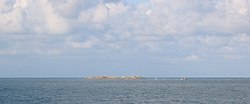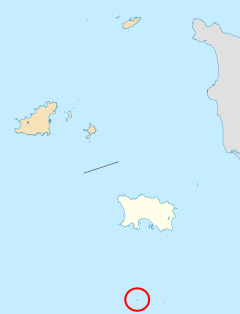Minquiers: Difference between revisions
| Line 78: | Line 78: | ||
{{Channel Islands}} | {{Channel Islands}} | ||
[[Category:Ramsar sites in the | [[Category:Ramsar sites in the Channel Islands]] | ||
Latest revision as of 22:56, 7 April 2020
| The Minquiers Jèrriais: Les Minquiers | |
 La Maîtr' Île | |
|---|---|
| Location | |
| Location: | 48°57’0"N, 2°7’59"W |
| Data | |
| Population: | Uninhabited |
The Minquiers, known also as Les Minquiers; in Jèrriais: Les Mîntchièrs known as "the Minkies" in local English) are a group of islands and rocks, about nine miles south of Jersey. The Minquiers forms part of the Bailiwick of Jersey.[1] They are administratively part of the Parish of Grouville, but uninhabited and uninhabitable.
At low tide, the rock shelf around the Minquiers has a larger surface area than Jersey itself but at high tide only a few of the main heads remain above water.[2] The largest of these is Maîtresse, which is about 55 yards long and 22 yards wide and has about ten stone cottages in various states of repair; these are the most southerly buildings in the British Isles. However, they have no permanent inhabitants, though fishermen, vraic (seaweed used for fertilizer) collectors, yachtsmen, kayakers, and even radio amateurs make summer landfall.[1]
In August 2018, one of the twenty buildings on the islands was sold to private individuals using a Jersey company. Only five sales have been recorded in 50 years.[3]
Name
The etymology of the name is disputed, and could either come from the Breton language minihi meaning a sanctuary, or from minkier meaning a seller of fish.[4]
Islets
The most significant islands in the group are:
- Maîtresse Île / Maîtr' Île
- Les Maisons;
Others include:
- Le Niêsant
- Les Faucheurs
- La Haute Grune.
History
Thousands of years ago, around the time of the last Ice Age, when sea level was lower, the Channel Islands were high ground on the plain connecting the European continent and southern Britain.
In the year 933, the Duchy of Normandy annexed the islets, along with the other Channel Islands and the Cotentin Peninsula. After William the Bastard, Duke of Normandy conquered England in 1066, the islands remained united to the Duchy until Philip Augustus conquered mainland Normandy in 1204, leaving only the islands in English hands. In 1259 King Henry III did homage to the French king for the Channel Islands. Edward III, in the 1360 Treaty of Brétigny, waived his claims to the crown of France and to Normandy, but reserved various other territories to England, including the Channel Islands.[5]
The 1911 Britannica says that Maîtresse Île "affords a landing and shelter for fishermen."
A small company of Wehrmacht soldiers on the Minquiers were among the last to surrender in the Second World War. A French fishing boat, skippered by Lucian Marie, approached the island of Minquiers and anchored nearby. A fully armed German soldier approached and asked for help saying 'We've been forgotten by the British, perhaps no one on Jersey told them we were here, I want you to take us over to England, we want to surrender'. This was on 23 May 1945, three weeks after the war in Europe ended.[6]
Resolution of disputed status
In 1950 the United Kingdom and France went to the International Court of Justice for friendly discussions to decide to which country the Minquiers and Ecrehos belonged.[1] The French fished in the waters, but Jersey exercised various administrative rights. The Court considered the historical evidence, and in its judgment of 17 November 1953 awarded the islands to Jersey (as represented by the United Kingdom).[5]
In 1998 some Frenchmen 'invaded' the Minquiers on behalf of the 'King of Patagonia' in 'retaliation' for the British recovery of the Falkland Islands.[1] The Union Jack was restored the next day.
Les Minquiers in literature
Notably, The Minquiers are mentioned at length by Victor Hugo in his novel Ninety-Three, about the French Revolution. He mentions how treacherous they are, and says that their combined area is bigger than mainland Jersey itself. Hugo lived in both Guernsey and Jersey at various points in his life, and so was familiar with local lore.
The British/French dispute over Les Minquiers is a plot element in Nancy Mitford's novel Don't Tell Alfred, as an occasional cause for dispute between the 'two old ladies' - France and Britain.
The Minquiers feature in the seafaring adventure novel The Wreck of the Mary Deare, by Hammond Innes, and its 1959 film adaptation.
Protection
The Minquiers are designated protected under the Ramsar convention.[7]
Pictures
-
Minquiers from the North Jersey.
-
Minquiers looking at inner basin from the South.
-
Minquiers looking at inner basin from the South. This is of the transit looking east.
-
Minquiers looking at inner basin from the South. This is of the transit looking east.
-
Minquiers looking at inner basin from the South. This is of the transit looking east.
-
Minquiers looking at inner basin from the South as the SE passage in taken towards Chaussey. This is of the transit looking east.
Outside links
| ("Wikimedia Commons" has material about Minquiers) |
References
- ↑ 1.0 1.1 1.2 1.3 "Les Minquiers (GH): 2007". Cambridge University Wireless Society. 2007. https://www.g6uw.org/2007/09/05/les-minquiers-gh-2007/.
- ↑ Jersey Birds, 2010
- ↑ 'Hut on fringe of British Isles sold' BBC News 21 August 2018
- ↑ Coysh, Victor: 'Channel Islets: The Lesser Channel Islands' (Guernsey Press Co Ltd, 1985) ISBN 0902550128
- ↑ 5.0 5.1 * Minquiers and Ecrehos (France/United Kingdom) – Summary of the Summary of the Judgment of 17 November 1953 Template:Webarchive, International Court of Justice
- ↑ Whiting, Charles (1973). The end of the war; Europe: April 15-May 23, 1945.. New York: Stein and Day. pp. 168. ISBN 0-8128-1605-6. OCLC 810423.
- ↑ "Les Minquiers, Jersey". Ramsar. https://rsis.ramsar.org/ris/1456.
- Files on the ICJ case can be found in the National Archives, mostly in the FO 371 sequence.
- Les Minquiers: article published in hidden europe magazine, 2006, Issue 6, pp. 38–39 (ISSN 1860-6318)
- Histoire des Minquiers et des Ecréhous. Robert Sinsoilliez. Editions l'Ancre de Marine.
- Channel Islets - Victor Coysh
| The Channel Islands |
|---|
|
Bailiwick of Guernsey: Guernsey • Alderney • Sark • Herm • Brecqhou • Burhou • Ortac • Les Casquets • Jethou • Lihou • Crevichon • Les Houmets |
|
Bailiwick of Jersey: Jersey • Les Écréhous • La Motte • Les Minquiers • Pierres de Lecq • Les Dirouilles |




